On the Post-Printing Heat Treatment of a Wire Arc Additively Manufactured ER70S Part
Abstract
1. Introduction
2. Materials and Methods
2.1. Material, Fabrication Process, and Post-Fabrication Heat Treatment
2.2. Microstructural Characterization
2.3. Mechanical Properties Evaluation
3. Results and Discussion
3.1. Microstructural Characterization
3.2. Mechanical Properties Evaluation
4. Conclusions
- The dominant microstructure of the as-printed WAAM-ER70S-6 component consisted of polygonal ferrite grains along with a small volume fraction of lamellar pearlite formed at the ferrite grain boundaries. In addition, the formation of acicular ferrite and bainite constituents were detected as the primary phases along the melt pool boundaries. Furthermore, a heat affected zone comprised of coarser polygonal ferrite grains adjacent to each deposited track in the previously solidified bead also formed, associated with the layer-by-layer deposition nature of the process, inducing multiple heating cycles on each deposited track.
- Normalizing heat treatment eliminated the meta-stable constituents, i.e., acicular ferrite and bainite, from the as-printed microstructure, leading to a more uniform and homogeneous ferritic/pearlitic microstructure within the melt pool center, fusion boundaries, and the heat affected zone. On the contrary, the hardening heat treatment altered the microstructure of the as-printed part to a combination of pearlite, bainite, and acicular ferrite.
- Microhardness of the as-printed sample slightly decreased from 160 ± 7 HV to 154 ± 1 HV after the normalizing heat treatment, while the hardening treatment could increase the microhardness to 260 ± 3 HV.
- Uniaxial tensile testing of the as-printed samples indicated a comparable tensile strength in horizontal and vertical samples, while a considerable anisotropy in the ductility with 35 ± 2% and 12 ± 3% of elongation, in horizontal and vertical directions, respectively, was apparent.
- Although the hardening heat treatment could increase the tensile strength of the component by around 20%, it intensified the anisotropy in the ductility of vertical and horizontal samples.
- The anisotropy in ductility was minimized by normalizing heat treatment due to the removal of the coarse grain regions in the HAZ and the resultant uniformity and homogeneity of the microstructure.
Author Contributions
Funding
Acknowledgments
Conflicts of Interest
References
- Cunningham, C.R.; Flynn, J.M.; Shokrani, A.; Dhokia, V.; Newman, S.T. Invited review article: Strategies and processes for high quality wire arc additive manufacturing. Addit. Manuf. 2018, 22, 672–686. [Google Scholar] [CrossRef]
- Posch, G.; Chladil, K.; Chladil, H. Material properties of CMT—metal additive manufactured duplex stainless steel blade-like geometries. Weld. World 2017, 61, 873–882. [Google Scholar] [CrossRef]
- Zhou, Y.; Zhang, L.; Wang, X.; Chen, Z.; Yuan, P.F. Exploration of computational design and robotic fabrication with wire-arc additive manufacturing techniques. In Proceedings of the Intelligent & Informed: 24th International Conference of Computer Aided Architectural Design Research in Asia, CAADRIA 2019, Wellington, New Zealand, 15–18 April 2019; pp. 143–152. [Google Scholar]
- Vahedi Nemani, A.; Ghaffari, M.; Nasiri, A. Comparison of microstructural characteristics and mechanical properties of shipbuilding steel plates fabricated by conventional rolling versus wire arc additive manufacturing. Addit. Manuf. 2020, 32, 101086. [Google Scholar] [CrossRef]
- Williams, S.W.; Martina, F.; Addison, A.C.; Ding, J.; Pardal, G.; Colegrove, P. Wire + Arc additive manufacturing. Mater. Sci. Technol. (UK) 2016, 32, 641–647. [Google Scholar] [CrossRef]
- Frazier, W.E. Metal additive manufacturing: A review. J. Mater. Eng. Perform. 2014, 23, 1917–1928. [Google Scholar] [CrossRef]
- Xiong, J.; Yin, Z.; Zhang, W. Closed-loop control of variable layer width for thin-walled parts in wire and arc additive manufacturing. J. Mater. Process. Technol. 2016, 233, 100–106. [Google Scholar] [CrossRef]
- Xiong, J.; Lei, Y.; Chen, H.; Zhang, G. Fabrication of inclined thin-walled parts in multi-layer single-pass GMAW-based additive manufacturing with flat position deposition. J. Mater. Process. Technol. 2017, 240, 397–403. [Google Scholar] [CrossRef]
- Ghaffari, M.; Vahedi Nemani, A.; Nasiri, A. Interfacial bonding between a wire arc additive manufactured 420 martensitic stainless steel part and its wrought base plate. Mater. Chem. Phys. 2020, 251, 123199. [Google Scholar] [CrossRef]
- Wang, Z.; Stoica, A.D.; Ma, D.; Beese, A.M. Diffraction and single-crystal elastic constants of Inconel 625 at room and elevated temperatures determined by neutron diffraction. Mater. Sci. Eng. A 2016, 674, 406–412. [Google Scholar] [CrossRef]
- Beese, A.M.; Carroll, B.E. Review of mechanical properties of Ti-6Al-4V made by laser-based additive manufacturing using powder feedstock. JOM 2016, 68, 724–734. [Google Scholar] [CrossRef]
- Sridharan, N.; Noakes, M.W.; Nycz, A.; Love, L.J.; Dehoff, R.R.; Babu, S.S. On the toughness scatter in low alloy C-Mn steel samples fabricated using wire arc additive manufacturing. Mater. Sci. Eng. A 2018, 713, 18–27. [Google Scholar] [CrossRef]
- Haden, C.V.; Zeng, G.; Carter, F.M.; Ruhl, C.; Krick, B.A.; Harlow, D.G. Wire and arc additive manufactured steel: Tensile and wear properties. Addit. Manuf. 2017, 16, 115–123. [Google Scholar] [CrossRef]
- Ghaffari, M.; Vahedi Nemani, A.; Rafieazad, M.; Nasiri, A. Effect of solidification defects and HAZ softening on the anisotropic mechanical properties of a wire arc additive-manufactured low-carbon low-alloy steel part. JOM 2019, 71, 4215–4224. [Google Scholar] [CrossRef]
- Rafieazad, M.; Ghaffari, M.; Nemani, A.V.; Nasiri, A. Microstructural evolution and mechanical properties of a low-carbon low-alloy steel produced by wire arc additive manufacturing. Int. J. Adv. Manuf. Technol. 2019, 105, 2121–2134. [Google Scholar] [CrossRef]
- Lopez, A.; Bacelar, R.; Pires, I.; Santos, T.G.; Sousa, J.P.; Quintino, L. Non-destructive testing application of radiography and ultrasound for wire and arc additive manufacturing. Addit. Manuf. 2018, 21, 298–306. [Google Scholar] [CrossRef]
- Szost, B.A.; Terzi, S.; Martina, F.; Boisselier, D.; Prytuliak, A.; Pirling, T.; Hofmann, M.; Jarvis, D.J. A comparative study of additive manufacturing techniques: Residual stress and microstructural analysis of CLAD and WAAM printed Ti-6Al-4V components. Mater. Des. 2016, 89, 559–567. [Google Scholar] [CrossRef]
- Wang, T.; Zhang, Y.; Wu, Z.; Shi, C. Microstructure and properties of die steel fabricated by WAAM using H13 wire. Vaccum 2018, 149, 185–189. [Google Scholar] [CrossRef]
- Xu, X.; Ganguly, S.; Ding, J.; Guo, S.; Williams, S.; Martina, F. Microstructural evolution and mechanical properties of maraging steel produced by wire + arc additive manufacture process. Mater. Charact. 2018, 143, 152–162. [Google Scholar] [CrossRef]
- Yang, K.V.; Rometsch, P.; Davies, C.H.J.; Huang, A.; Wu, X. Effect of heat treatment on the microstructure and anisotropy in mechanical properties of A357 alloy produced by selective laser melting. Mater. Des. 2018, 154, 275–290. [Google Scholar] [CrossRef]
- DeRuntz, B.D. Assessing the benefits of surface tension transfer® welding to industry. J. Ind. Technol. 2003, 19, 1–8. [Google Scholar]
- Benscoter, A.O.; Bramfitt, B.L. Metallography and microstructures of low-carbon and coated steels. Metallogr. Microstruct. 2004, 9, 588–607. [Google Scholar]
- ASTM International. Standard Test Methods for Tension Testing of Metallic Materials; ASTM International: West Conshohocken, PA, USA, 2016. [Google Scholar]
- Haselhuhn, A.S.; Wijnen, B.; Anzalone, G.C.; Sanders, P.G.; Pearce, J.M. In Situ formation of substrate release mechanisms for gas metal arc weld metal 3-D printing. J. Mater. Process. Technol. 2015, 226, 50–59. [Google Scholar] [CrossRef]
- Lee, H.K.; Kim, K.S.; Kim, C.M. Fracture resistance of a steel weld joint under fatigue loading. Eng. Fract. Mech. 2000, 66, 403–419. [Google Scholar] [CrossRef]
- Kim, Y.M.; Lee, H.; Kim, N.J. Transformation behavior and microstructural characteristics of acicular ferrite in linepipe steels. Mater. Sci. Eng. A 2008, 478, 361–370. [Google Scholar] [CrossRef]
- Yang, X.; Salem, M.; Palmiere, E.J. The effect of processing conditions and cooling rate on the microstructure and properties of API X-70 and API X-100 steels. Mater. Manuf. Process. 2010, 25, 48–53. [Google Scholar] [CrossRef]
- Hwang, B.; Kim, Y.M.; Lee, S.; Kim, N.J.; Ahn, S.S. Correlation of microstructure and fracture properties of API X70 pipeline steels. Metall. Mater. Trans. A 2005, 36, 725–739. [Google Scholar] [CrossRef]
- Mohandas, T.; Madhusudan Reddy, G.; Satish Kumar, B. Heat-affected zone softening in high-strength low-alloy steels. J. Mater. Process. Technol. 1999, 88, 284–294. [Google Scholar] [CrossRef]
- Shi, X.; Ma, S.; Liu, C.; Wu, Q.; Lu, J.; Liu, Y.; Shi, W. Selective laser melting-wire arc additive manufacturing hybrid fabrication of Ti-6Al-4V alloy: Microstructure and mechanical properties. Mater. Sci. Eng. A 2017, 684, 196–204. [Google Scholar] [CrossRef]
- Shassere, B.; Nycz, A.; Noakes, M.W.; Masuo, C.; Sridharan, N. Correlation of microstructure and mechanical properties of metal big area additive manufacturing. Appl. Sci. 2019, 9, 787. [Google Scholar] [CrossRef]
- Huda, N.; Midawi, A.R.H.; Gianetto, J.; Lazor, R.; Gerlich, A.P. Influence of martensite-austenite (MA) on impact toughness of X80 line pipe steels. Mater. Sci. Eng. A 2016, 662, 481–491. [Google Scholar] [CrossRef]
- Lacalle, R.; Álvarez, J.A.; Ferreño, D.; Portilla, J.; Ruiz, E.; Arroyo, B.; Gutiérrez-Solana, F. Influence of the flame straightening process on microstructural, mechanical and fracture properties of S235 JR, S460 ML and S690 QL structural steels. Exp. Mech. 2013, 53, 893–909. [Google Scholar] [CrossRef]
- Kowal, M.; Szala, M. Diagnosis of the microstructural and mechanical properties of over century-old steel railway bridge components. Eng. Fail. Anal. 2020, 110, 104447. [Google Scholar] [CrossRef]
- Natividad, C.; García, R.; López, V.H.; Falcón, L.A.; Salazar, M. Mechanical and metallurgical properties of grade X70 steel linepipe produced by non-conventional heat treatment. In Characterization of Metals and Alloys; Springer: Cham, Switzerland, 2017; pp. 3–11. [Google Scholar]
- Bordbar, S.; Alizadeh, M.; Hashemi, S.H. Effects of microstructure alteration on corrosion behavior of welded joint in API X70 pipeline steel. Mater. Des. 2013, 45, 597–604. [Google Scholar] [CrossRef]
- Wang, Z.; Palmer, T.A.; Beese, A.M. Effect of processing parameters on microstructure and tensile properties of austenitic stainless steel 304L made by directed energy deposition additive manufacturing. Acta Mater. 2016, 110, 226–235. [Google Scholar] [CrossRef]
- Wang, Z.; Beese, A.M. Effect of chemistry on martensitic phase transformation kinetics and resulting properties of additively manufactured stainless steel. Acta Mater. 2017, 131, 410–422. [Google Scholar] [CrossRef]
- Carroll, B.E.; Palmer, A.; Beese, A.M. Anisotropic tensile behavior of Ti–6Al–4V components fabricated with directed energy deposition additive manufacturing. Acta Mater. 2015, 87, 309–320. [Google Scholar] [CrossRef]
- Zhang, Q.; Chen, J.; Zhao, Z.; Tan, H.; Lin, X.; Huang, W. Microstructure and anisotropic tensile behavior of laser additive manufactured TC21 titanium alloy. Mater. Sci. Eng. A 2016, 673, 204–212. [Google Scholar] [CrossRef]
- Thijs, L.; Sistiaga, M.L.M.; Wauthle, R.; Xie, Q.; Kruth, J.-P.; Van Humbeeck, J. Strong morphological and crystallographic texture and resulting yield strength anisotropy in selective laser melted tantalum. Acta Mater. 2013, 61, 4657–4668. [Google Scholar] [CrossRef]
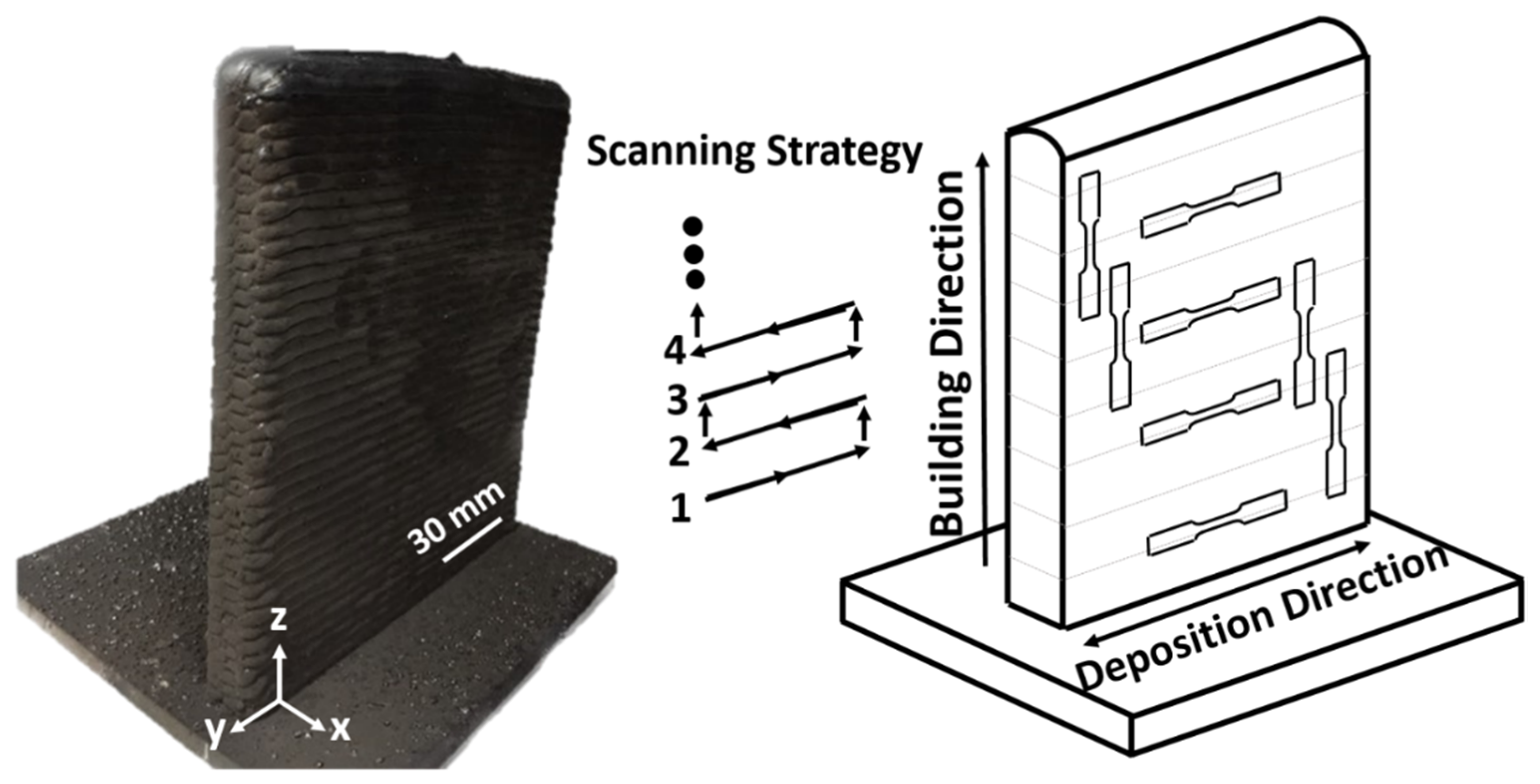
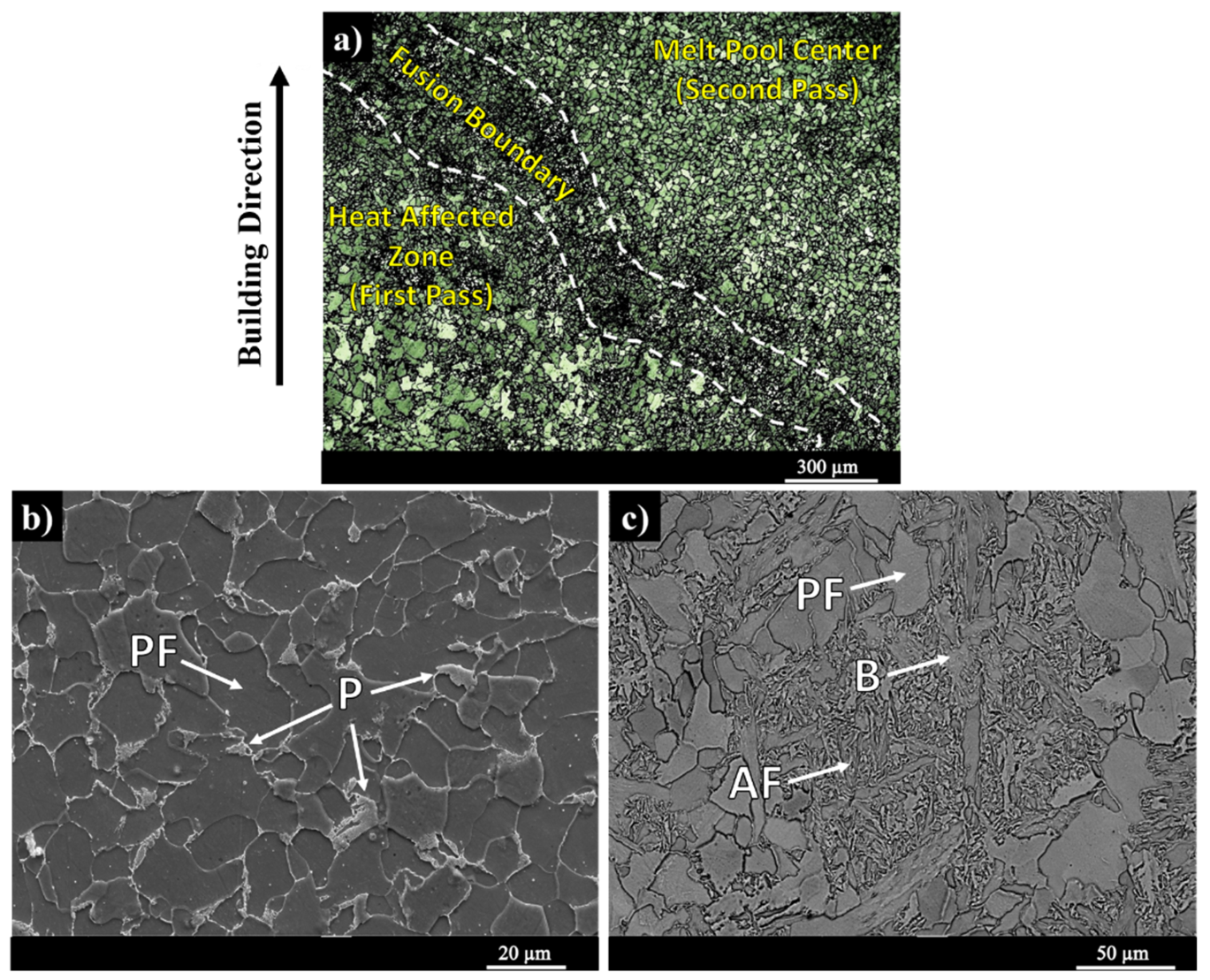
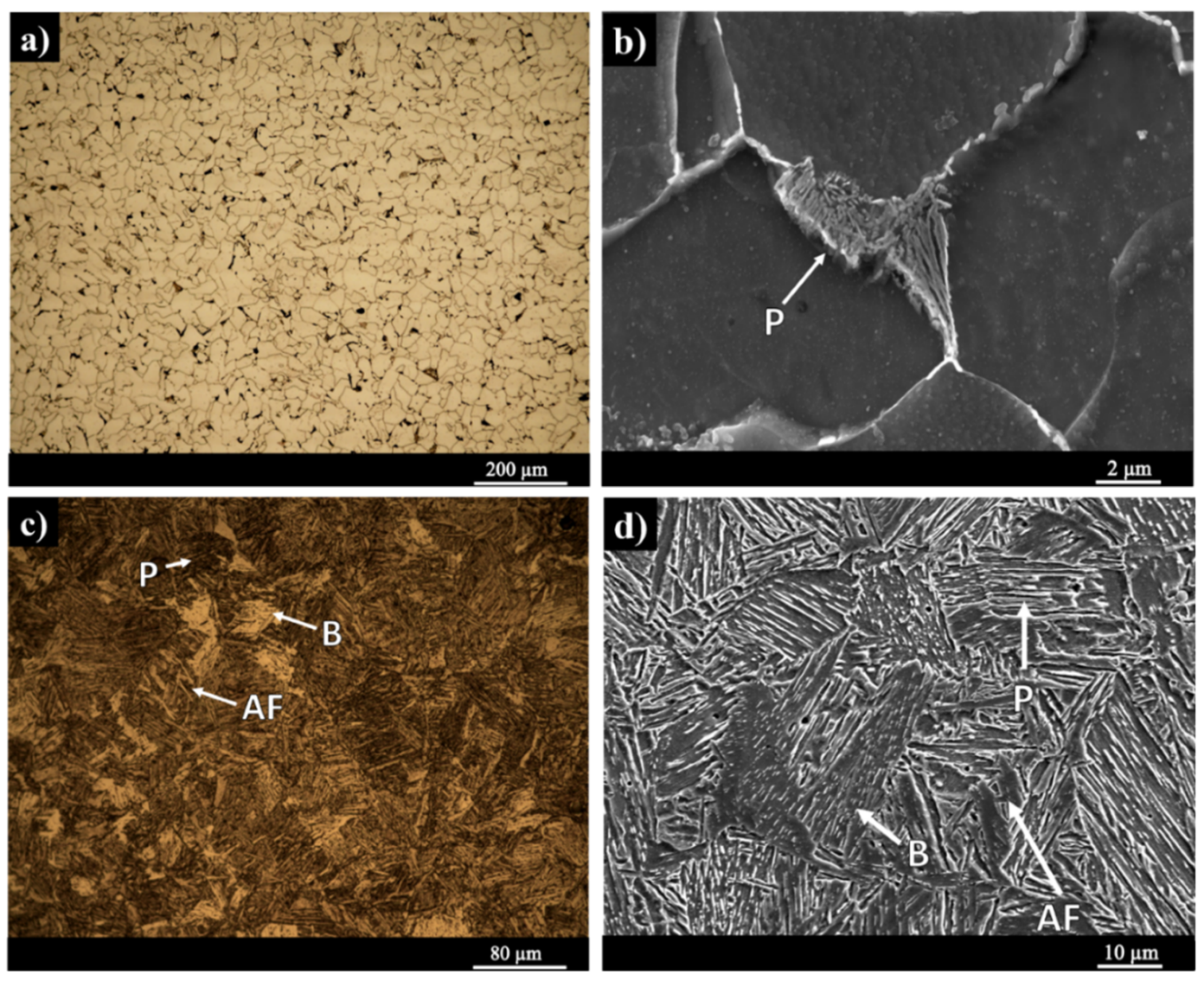
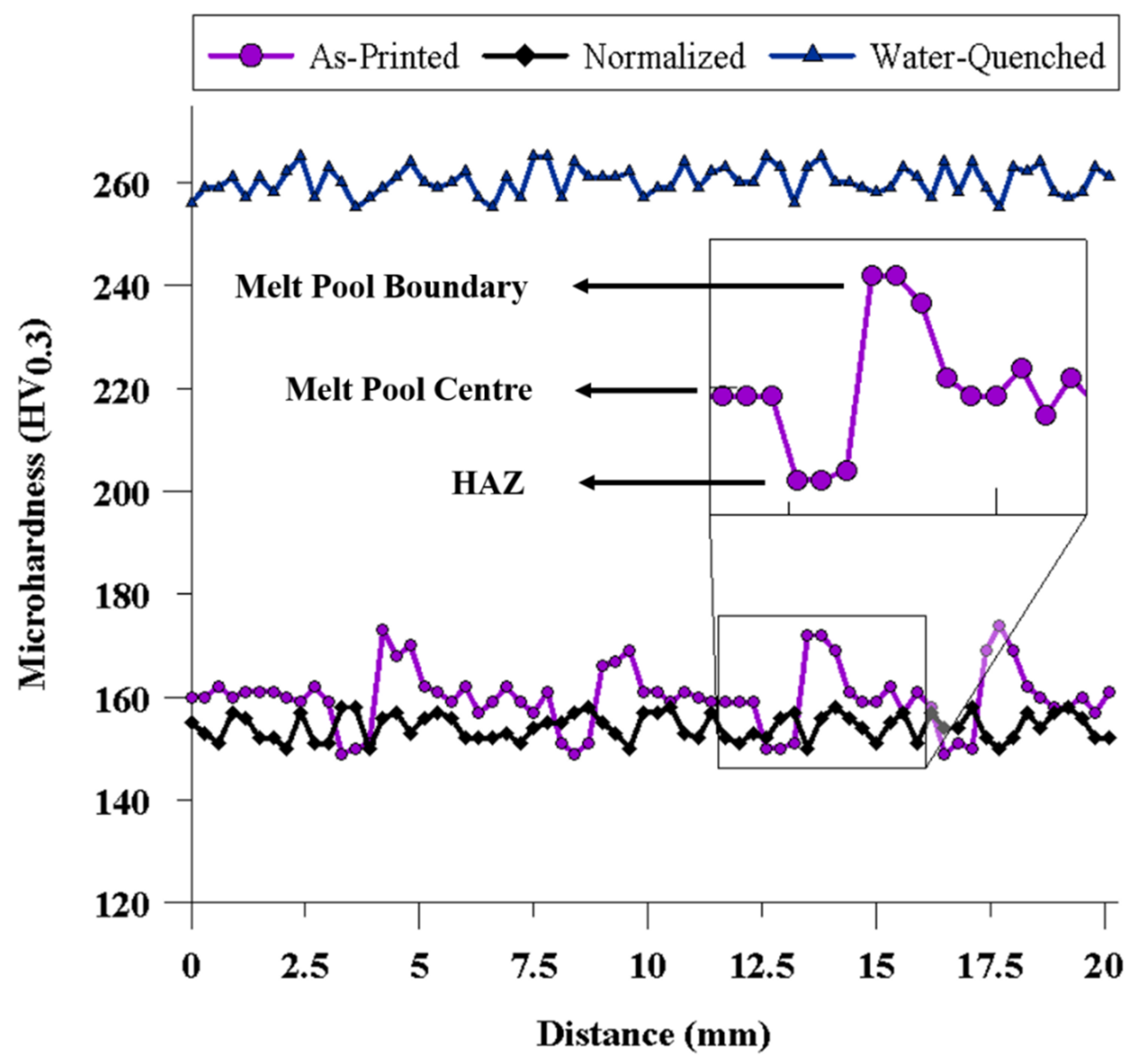
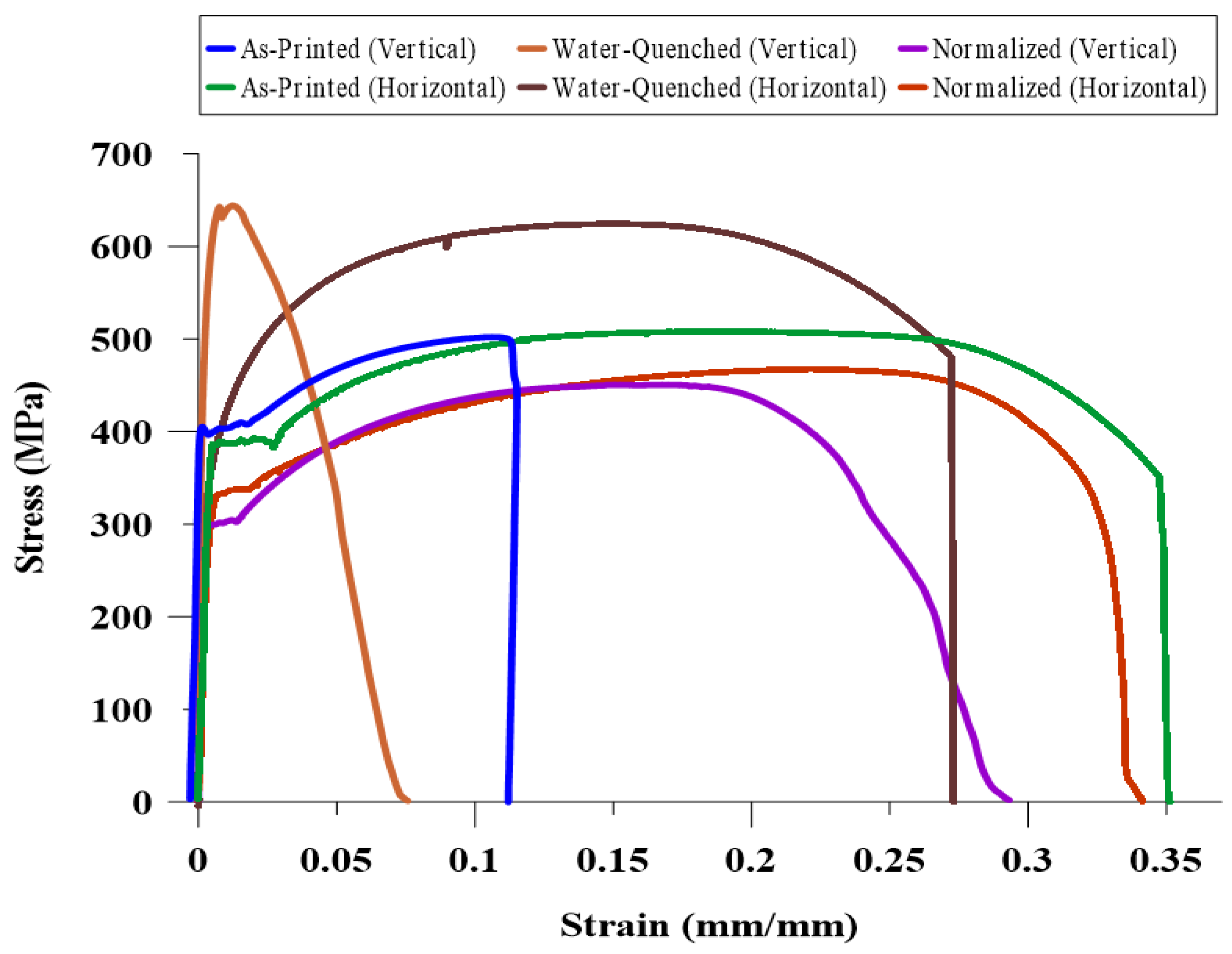
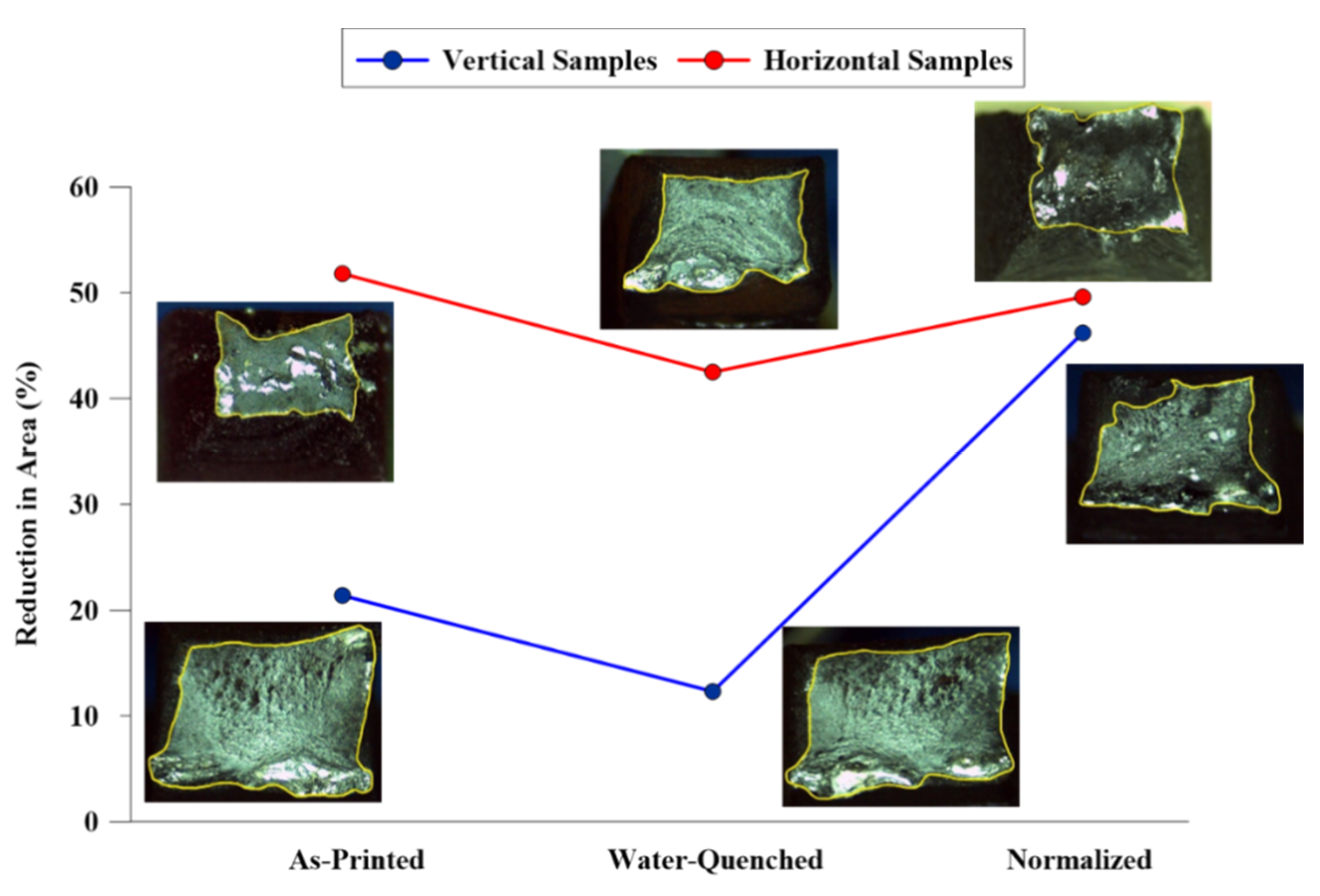
| C | Mn | Si | S | P | Cr | Ni | Mo | V | Cu | Fe |
|---|---|---|---|---|---|---|---|---|---|---|
| 0.06–0.15 | 1.40–1.85 | 0.80–1.15 | 0.04 max | 0.03 max | 0.15 max | 0.15 max | 0.15 max | 0.03 max | 0.5 max | Bal. |
| Average Arc Current | Arc Voltage | Wire Feeding Rate | Scanning Rate | Argon Flow Rate | Heat Input |
|---|---|---|---|---|---|
| 135 A | 28 V | 104 mm/s | 5 mm/s | 20 L/min | 7.56 kJ/cm |
© 2020 by the authors. Licensee MDPI, Basel, Switzerland. This article is an open access article distributed under the terms and conditions of the Creative Commons Attribution (CC BY) license (http://creativecommons.org/licenses/by/4.0/).
Share and Cite
Vahedi Nemani, A.; Ghaffari, M.; Nasiri, A. On the Post-Printing Heat Treatment of a Wire Arc Additively Manufactured ER70S Part. Materials 2020, 13, 2795. https://doi.org/10.3390/ma13122795
Vahedi Nemani A, Ghaffari M, Nasiri A. On the Post-Printing Heat Treatment of a Wire Arc Additively Manufactured ER70S Part. Materials. 2020; 13(12):2795. https://doi.org/10.3390/ma13122795
Chicago/Turabian StyleVahedi Nemani, Alireza, Mahya Ghaffari, and Ali Nasiri. 2020. "On the Post-Printing Heat Treatment of a Wire Arc Additively Manufactured ER70S Part" Materials 13, no. 12: 2795. https://doi.org/10.3390/ma13122795
APA StyleVahedi Nemani, A., Ghaffari, M., & Nasiri, A. (2020). On the Post-Printing Heat Treatment of a Wire Arc Additively Manufactured ER70S Part. Materials, 13(12), 2795. https://doi.org/10.3390/ma13122795






